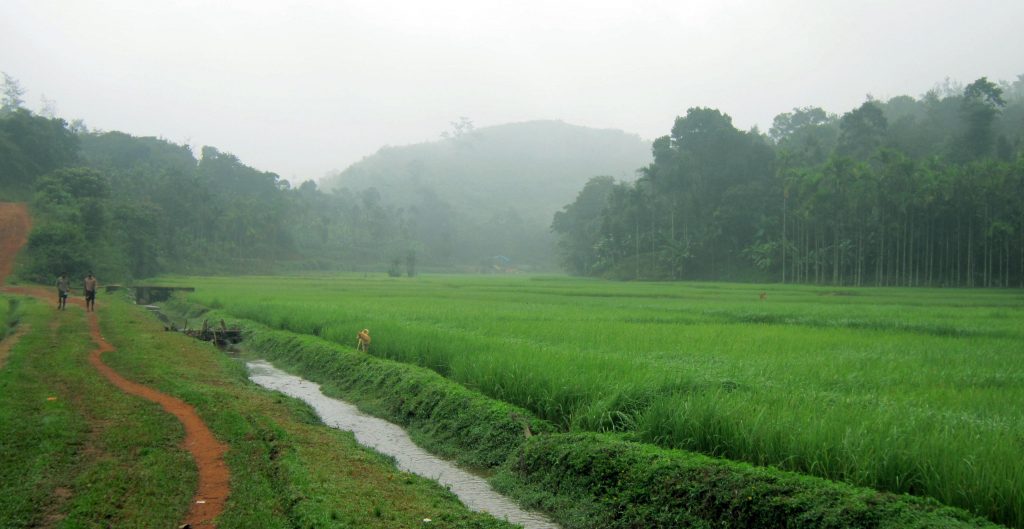
Kurichya farmers of Wayanad district practice collective family farming by holding large areas of land through a unique family organisation. Kurichyas are “one of the largest joint families ever reported in anthropological literature” (Aiyappan and Mahadevan, 2008). These landed agriculturalists have organised themselves into big joint families. They are well known for organised game hunting, conservation of diverse plant and animal species, and for the immense traditional knowledge they possess on the natural resources around them (Kumar et al., 2010).
A Kurichyamittom is a joint family of more than 100 members living in one single house complex with a large area of land under possession (Chacko, 1994; Kumar and Vedavalli, 1996; Ravivarma 2004). The agrarian system of the Kurichyasis based on collective ownership of land, cooperative agriculture and kinship labour (Aiyappan and Mahadevan 2008). It resembles the agrarian society of Kerala before the introduction of the caste system in the Sangam period. The unique social organisation based on matrilineal succession and the subsistence-based agriculture complemented each other to survive as a sustainable natural resource management model.
Contribution to Biodiversity Conservation:
Currently the Kurichyas conserve 12 land races of paddy, many vegetables, 13 varieties of banana and numerous medicinal plants and tubers in their homesteads. Cheruvayal Raman, a Kurichya farmer in Wayanad is conserving over 40 landraces of rice on-farm for the last several years by painstakingly multiplying every year and keeping the seed purity. In hillslopes, they cultivate coffee and other cash crops. Diverse food crops, varieties of traditional rice germplasm, medicinal trees, sacred groves and life-saving crops that can withstand adverse environmental conditions like drought, flood, etc., are found in Kurichya lands (Kumar et al., 2010). The culture and tradition of the Kurichya is associated with biodiversity. Rice varieties like Chennellu, Veliyan and Gandhakasala are common offerings at religious rituals and feasts. The cultivated diversity of vegetables, rice and other cereals and tubers in a Kurichya homestead is still the highest among the communities in the region. The Kurichya community includes traditional healers, basket weavers and skilled carpenters, and there are a number of native plants associated with their work traditions. More than 50 species of inland fish and numerous plant species seen in the paddy fields are part of the Kurichya diet. The game meat from the neighbouring forests was an integral part of Kurichya culture and diet, until the enactment of the Indian Wildlife Protection Act in 1972.
Rituals and Beliefs of Kurichya
The Kurichya joint family system is rooted in its culture, and is expressed through numerous rituals and beliefs. There are three types of rituals observed in a year: life-cycle rituals of individuals, annual offerings to the deities and rituals associated with agriculture. Important life-cycle rituals are observed on birth, puberty (for girls), marriage, and death of an individual. All these rituals are the responsibility of the maternal mittom of the individual, irrespective of gender. It is the responsibility of all members to be present and organise the annual offerings to the family gods and goddesses. There are six different rituals associated with rice cultivation. All of these are observed in the first season (nanja) of rice cultivation. Specific rituals are associated with different rice varieties, based on crop duration and special characteristics. Thus variety conservation is greatly integrated with culture. The whole process of collective rice cultivation is ritualistic. First the koottam (assembly) is called to get permission from the negal and Thampayi(God). Every stage of cultivation is started with a ritual. Sowing of the first seed for raising the nursery (vithidal) is observed on the very next day after Vishu (the popular harvest festival of Kerala). Beginning of transplanting of rice is nattivaekkal. This is started witha big feast called sambalamoot. Buffaloes are worshipped before starting ploughing and land preparation. The Kurichyas believe that Makam in the Malayalam month, Kanni is the birth star of rice. To celebrate the day, they worship the blooming first rice panicles. The following month is the celebration of reaping the first rice panicle of the season. The ritual associated with this is called kathirukettal and after this they go for a ritualistic game hunt in the nearby forests. Koythuthudakkam is the official beginning of the harvest. At the end of harvesting, they conduct putharikolu, which is the offering to God as a ‘thanksgiving’ for a good harvest.
As an agricultural and hunting community, they consider land and their family members as important assets. They worship the ancestral spirit (negal/muni) as the sole owner of their properties. The man who established the mittom by acquiring land and mobilising the clan becomes a negal (shadow) after his death. The whole system works in the belief that the land and the family is the property of the negal. The present generation has to protect these resources as custodians. Kunjukuttiyummakkalum (the sisters and their children) are the second concern of the Kurichya system. Property rights and membership in the family descend through the female members. Farming, herding cattle, maintaining the house and cooking are the main chores of a Kurichyamittom.
Based on the doctoral research of Suma T R, Scientist, Community Agrobiodiversity Centre of MSSRF

